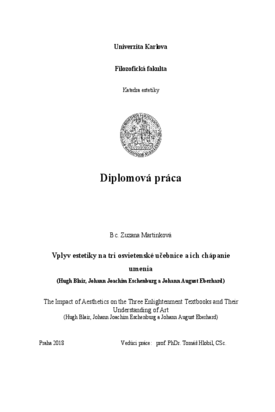Tri učebnice estetiky (Hugh Blair, Johann Joachim Eschenburg a Johann August Eberhard).
Three textbooks of aesthetics (Hugh Blair, Johann Joachim Eschenburg and Johann August Eberhard).
Tři učebnice estetiky (Hugh Blair, Johann Joachim Eschenburg a Johann August Eberhard).
diplomová práce (OBHÁJENO)

Zobrazit/
Trvalý odkaz
http://hdl.handle.net/20.500.11956/102770Identifikátory
SIS: 191442
Kolekce
- Kvalifikační práce [24991]
Autor
Vedoucí práce
Oponent práce
Dykast, Roman
Fakulta / součást
Filozofická fakulta
Obor
Estetika
Katedra / ústav / klinika
Katedra estetiky
Datum obhajoby
6. 9. 2018
Nakladatel
Univerzita Karlova, Filozofická fakultaJazyk
Slovenština
Známka
Výborně
Klíčová slova (česky)
estetika|krásne vedy a umenia|poetika|rétorika|učebnice|Blair|Eberhard|EschenburgKlíčová slova (anglicky)
aesthetics|beautiful sciences and arts|poetics|rhetorics|textbooks|Blair|Eberhard|EschenburgPráca skúma tri osvietenské učebnice dobových teórií slovesných umení, ktoré boli vydané v rovnakom roku 1783 a významne sa podielali na šírení estetických ideí. Jej primárnou snahou je zistiť, nakoľko estetika ako samostatná filozofická disciplína prenikala do týchto troch vybraných učebnicových textov dobových teórií umení, a v akých smeroch pôsobila na ich výklad. Kladie si otázku, ako prítomnosť či absencia estetiky ovplyvnila poňatie týchto textov nielen ako celku, ale i v rozvíjaní konkrétnych teórií, tém a ideí a vzájomne ich porovnáva. Postupuje po jednotlivých hlavných celkoch učebníc a predstavuje ich základnú výstavbu i konkrétne stanoviská, ktoré následne porovnáva a vyhodnocuje. Cieľom práce je postihnúť charakter výkladu a uchopenie teórie jednotlivých druhov umení podľa toho, či sa odohrávali v rámci estetiky alebo mimo nej. Predložená práca tak má byť príspevkom k lepšiemu pochopeniu rozdielov a zhôd nemeckého a škótskeho tematizovania estetických otázok na sklonku 18 st. na základe týchto troch príkladov učebných textov.
The thesis examines three enlightenment textbooks of literary arts of that period, which were all published in 1783 and significantly contributed to dissemination of aesthetic ideas. Its primary aim is to determine how aesthetics, as a separate philosophical discipline, entered into these three selected textbooks of literary arts of that period, and in what ways it has influenced their interpretation. It raises a question of how the presence or absence of aesthetics influenced the concept of these texts not only as a whole, but also in developing specific theories, themes and ideas that are further compared in this thesis. It analyses the main sections of the textbooks and introduces their basic structure and specific opinions, which are then critically evaluated. The aim of the thesis is to examine the character of the interpretations and grasp the theories of particular kinds of arts depending on whether they were performed within or outside the framework of aesthetics. The presented thesis should contribute to a better understanding of the differences and similarities between German and Scottish reflections of aesthetic questions at the end of 18th century based on these three examples of textbooks.
